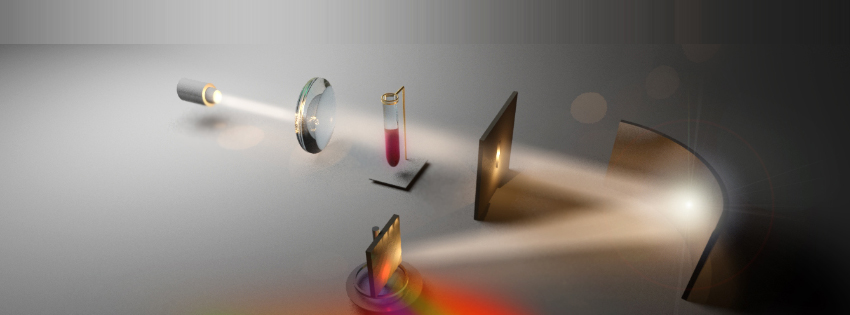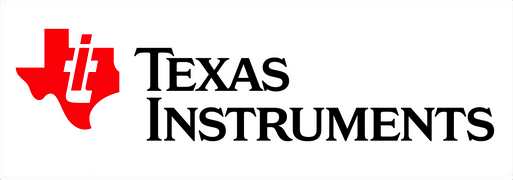Sample Interrogation
The first step in any spectroscopic measurement is to interrogate the sample in question with an optical beam and then direct light from the sample to the spectrometer for analysis. The sample can either be placed at the same location as the spectrometer or accessed at a distance through a fiber optic cable. Light from an appropriately chosen source is then directed toward the sample, typically through one or more lenses to create a beam of a desired size and divergence at the sample. The light to be directed to the spectrometer can either be the light that is reflected from the surface of the sample (reflective interrogation) or the light that is transmitted through the thickness of the sample (transmissive interrogation). A second set of optics collects light coming from the sample and directs it toward the entrance slit of the spectrometer. The size and divergence of the light beam at the slit should ideally be chosen to maximize the amount of optical power that is able to enter the spectrometer for analysis.
In selecting an interrogation module for a given application, there are several options that should be considered. First, it is important to select the correct form of interrogation, either reflective or transmissive. Second, it is important to select an optical source that provides the power and spectral range needed for the measurement. Third, an optical system with beam shaping and image formation properties must be selected to provide the best delivery of light to the sample and to the entrance slit of the spectrometer.
Transmissive vs. Reflective Interrogation:
The choice of transmission or reflection depends on the parameters of the application, including the property of the sample being measured and the physical properties of the sample, such as its size (a side of beef or a vial of liquid), its optical properties (clarity, for example), and means of access (is the sample in a flowing pipeline or can it be removed for analysis purposes).
Transmissive interrogation is typically used when measuring absorption or forward scattering of a sample and the sample has sufficient optical clarity to allow the optics to collect sufficient optical power for accurate analysis by the spectrometer. The clarity requirement usually imposes an upper limit on the thickness of the sample. Typically, transmissive applications have samples of less than a few centimeters in thickness. In-line measurements of liquids and solutions during processing for the purpose of process control have most often been performed using transmissive interrogation.
Reflective interrogation is typically used when measuring scattering, surface properties, or when measuring absorption of large or opaque samples. Examples include determining the fat content of a side of beef before processing and the quality of wool obtained from a sheep (or even still on the sheep!).
Choosing an Optical Source:
The most important property of an optical source for spectroscopic measurements is the range of wavelengths over which the source emits light. Absorption, diffraction, and scattering have very specific dependence on wavelength. In order to make the desired measurement, the source must emit light in a wavelength range that will capture this dependence for analysis purposes. For example, most targets of interest in the food industry have their important absorption or scattering properties located in the infrared, so the use of a visible light source would not be appropriate. The bandwidth of the source – roughly defined as the range of wavelengths for which a certain minimum power is emitted – is also important. Most often it is desirable to use a source that has a large bandwidth in order to capture the most information about the wavelength dependence of the process being analyzed. For portable spectrometers such as the Nano, an LED is a common choice of source, as typical LEDs have bandwidths around 30 nm.
The second property of the source to consider is the optical power emitted by the source. In general, when more optical power is available to the spectrometer, the accuracy of the analysis increases and processing time of the analysis decreases. High power sources may not be needed if the sample reflects or transmits efficiently, allowing most of the light from a lower power source to be collected. Multiple, higher power LEDs can be selected for the interrogation modules of the Nano to increase the available source power. Increasing the power further would require the use of a super-luminescent diode (bandwidth of an LED, brightness of a weaker laser) or a broader-band laser source.
Telecentric vs. Non-telecentric Optical System:
An optical system is classified as either telecentric or non-telecentric based on whether or not the image formed by the system is constant in size or magnification with changes in the distance between the object and the front plane of the optical system.
A non-telecentric system is one where the image size changes with changes in the object distance due to variations in the magnification of the lens system. For spectrometers, where the entrance slit is small and fixed in size, the use of a non-telecentric system for collecting light from the sample would require the sample to be a fixed distance (or a very narrow range of distances) from the front surface of the first collecting lens to ensure that the greatest percentage of the collected light would fall within the open area of the entrance slit. Non-telecentric designs also have entrance pupils within or close to the lens system, resulting in light rays traveling at large angles with respect to the optical axis of the lens system at the plane of the entrance slit. Since the entrance slit is selected to block rays traveling at large angles from entering the system, optical power in these rays is lost to the spectrometer. Thus the cost of a non-telecentric design lies in the potential reduction in spectrometer performance. The benefit of a non-telecentric design is the relative simplicity of the optics and a typically lower purchase cost.
A telecentric system is one where the image size changes very little over a longer range of object distances, and is said to produce an orthographic projection. The system is designed such that only rays that are parallel or nearly parallel to the optical axis are collected, and the angle of the rays at the output of the system are likewise parallel or nearly parallel to the optical axis (exit pupil near infinity). The very nearly constant image size and the low angles of the rays with respect to the optical axis can greatly increase the amount of power collected from the sample that is successfully coupled into the spectrometer through the entrance slit. As noted previously, more available power improves the performance of the spectrometer. Another property of the telecentric lens is the formation of an image (or a focal spot) within the length of the system. For an interrogation module, this means that potentially the light from the source can be focused at or in the sample, providing either spatial selectivity of the measurement or higher intensity (power per unit area) that might be important for interrogating intensity-dependent processes within the sample.


